Recommended Reading List
AboutNeurofeedback.com’s Recommended Reading List

Healing Young Brains: The Neurofeedback Solution
by Robert W. Hill, PhD and Eduardo Castro, MD
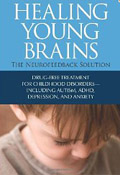 Very easy to read. A great parent’s guide to neurofeedback and other non-drug options for ADHD, learning disabilities, mood, and more. Dr. Castro, an M.D., and Dr. Hill, a psychologist, spent years seeing kids struggle with standard medication treatments. Drawing on 20+ years experience, they explain why neurofeedback and other non-medication approaches help kids far more than traditional methods, often with life-long results. Castro and Hill point out that there are many experts in diagnosing, but many have little to offer in solving the problem.
Very easy to read. A great parent’s guide to neurofeedback and other non-drug options for ADHD, learning disabilities, mood, and more. Dr. Castro, an M.D., and Dr. Hill, a psychologist, spent years seeing kids struggle with standard medication treatments. Drawing on 20+ years experience, they explain why neurofeedback and other non-medication approaches help kids far more than traditional methods, often with life-long results. Castro and Hill point out that there are many experts in diagnosing, but many have little to offer in solving the problem.

Introduction to Quantitative EEG and Neurofeedback, Second Edition: Advanced Theory and Applications
Edited by Thomas H. Budzynski, Helen Kogan Budzynski, James R. Evans, & Andrew Abarbanel
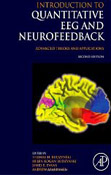 This book is for health and education professionals, academics, and even laypeople who want a solid foundation of science, theory, and applications for neurofeedback and qEEG. (qEEG is an EEG-based brain map often used to guide neurofeedback training). Each chapter is like taking a short course from top professionals in the field (30 authors and co-authors created 18 different chapters). It’s an impressive collection. It’s clearly the best source for a comprehensive introduction to qEEG brain mapping and LORETA. It’s perhaps the only text that discusses how multidisciplinary research underlies qEEG and neurofeedback and its application.
This book is for health and education professionals, academics, and even laypeople who want a solid foundation of science, theory, and applications for neurofeedback and qEEG. (qEEG is an EEG-based brain map often used to guide neurofeedback training). Each chapter is like taking a short course from top professionals in the field (30 authors and co-authors created 18 different chapters). It’s an impressive collection. It’s clearly the best source for a comprehensive introduction to qEEG brain mapping and LORETA. It’s perhaps the only text that discusses how multidisciplinary research underlies qEEG and neurofeedback and its application.
Getting Started with Neurofeedback
by John N. Demos
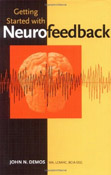 Getting Started with Neuorfeedback is written like a textbook. It’s targeted at clinicians who want to learn how to do neurofeedback, or at least understand it better. It does a good job of reviewing basic concepts in neurofeedback that new clinicians should be familiar with, sooner versus later. The book is more basic than the Introduction to Quantitative EEG and Neurofeedback book, more of a primer. It’s not possible to fully learn how to do neurofeedback out of a textbook (hands-on training is necessary), but this is good introduction to one point of view and a useful reference.
Getting Started with Neuorfeedback is written like a textbook. It’s targeted at clinicians who want to learn how to do neurofeedback, or at least understand it better. It does a good job of reviewing basic concepts in neurofeedback that new clinicians should be familiar with, sooner versus later. The book is more basic than the Introduction to Quantitative EEG and Neurofeedback book, more of a primer. It’s not possible to fully learn how to do neurofeedback out of a textbook (hands-on training is necessary), but this is good introduction to one point of view and a useful reference.
The first half offers explanations, such as a history of the field; a simple neurophysiology overview; an introduction to biofeedback, neurofeedback, and qEEG; EEG concepts and frequency bands; how the EEG is recorded; sensor placements; basics of how the neurofeedback systems work; and EEG frequency bands (delta, beta, alpha, etc).
Part II targets an overview of some clinical approaches to implementing neurofeedback, including issues surrounding the creation of treatment plans, assessment issues, and issues regarding selecting protocols (the frequency and site used for training). There are many approaches to doing neurofeedback, and this text presents a helpful description of one of them.
Reviewed by Michael Cohen, Director, Center for Brain Training
Biofeedback for the Brain: How Neurotherapy Effectively Treats Depression, ADHD, Autism, and More
by Paul Swingle
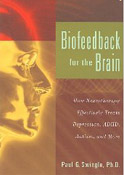 Dr. Paul Swingle was a professor of psychology for years at the University of Ottawa and also lectured in psychiatry at Harvard Medical School for a number of years. He’s a very bright, very practical guy who has built one of the most successful neurofeedback practices we know about. He’s also created a model of brain function and how to train it. Most importantly, he’s very good at explaining a complex subject in ways to make it understandable to both professionals and health consumers. If you’re looking for a “hard science” book, this isn’t it. If you want to gain a better understanding of how the brain works and how neurofeedback influences it, this is a solid book with a lot of information. Definitely recommended reading.
Dr. Paul Swingle was a professor of psychology for years at the University of Ottawa and also lectured in psychiatry at Harvard Medical School for a number of years. He’s a very bright, very practical guy who has built one of the most successful neurofeedback practices we know about. He’s also created a model of brain function and how to train it. Most importantly, he’s very good at explaining a complex subject in ways to make it understandable to both professionals and health consumers. If you’re looking for a “hard science” book, this isn’t it. If you want to gain a better understanding of how the brain works and how neurofeedback influences it, this is a solid book with a lot of information. Definitely recommended reading.
Reviewed by Michael Cohen, Director, Center for Brain Training
A Symphony in the Brain
by Jim Robbins
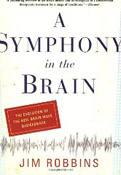 New to neurofeedback and looking for a book to help you get a solid introduction to the field? A Symphony in the Brain, which author Jim Robbins has revised and expanded for the new edition, helps its readers gain a real sense for neurofeedback. Robbins’ work stands out not only for being a great introduction to neurofeedback, but also a very well-written and readable book, thanks to his expertise as a professional science writer. A Symphony in the Brain includes a valuable introduction to the research and history of the field, as well as compelling case studies of people who have been treated with neurofeedback.
New to neurofeedback and looking for a book to help you get a solid introduction to the field? A Symphony in the Brain, which author Jim Robbins has revised and expanded for the new edition, helps its readers gain a real sense for neurofeedback. Robbins’ work stands out not only for being a great introduction to neurofeedback, but also a very well-written and readable book, thanks to his expertise as a professional science writer. A Symphony in the Brain includes a valuable introduction to the research and history of the field, as well as compelling case studies of people who have been treated with neurofeedback.
Reviewed by Michael Cohen, Director, Center for Brain Training
Drug Induced Dementia: A Perfect Crime
by Grace E. Jackson, MD
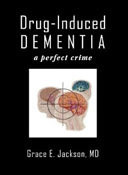 This very credible, very well-researched book is important in that it points out the compelling need for other treatments that are effective. Neurofeedback and brain nutrition are two of the most important options.
This very credible, very well-researched book is important in that it points out the compelling need for other treatments that are effective. Neurofeedback and brain nutrition are two of the most important options.
Dr. Grace Jackson, a board-certified psychiatrist, poses questions almost no one else is asking publicly. Dr. Jackson does a brilliant job of presenting research from many sources –from animal science to neuroimaging. She presents very compelling research no one is pointing out or advocating. For psychiatrists, other MDs and pharmaceutical companies, it may be a very uncomfortable book.
In her book, Dr. Grace Jackson writes, “The pervasive prescribing of psychiatric drugs to children and adolescents is one of the greatest public health crises in the history of modern medicine. We will quite likely see an epidemic of early-onset dementia in 40 to 60-year-olds as these children and adolescents grow up. Tragically, many will die prematurely a result of the physical harm caused by these drugs.”
Anyone taking psychiatric medications for a long time or who knows someone who is should be aware of the risks. They likely aren’t getting that information elsewhere. This book gives them a clearer picture of risks. She points out in particular the reasons why existing drug treatments are particularly hazardous for survivors of traumatic brain injury and stroke.
Reviewed by Michael Cohen, Director, Center for Brain Training
Healing ADD: The Breakthrough Program That Allows You to See and Heal the 6 Types of ADD
by Daniel G. Amen, MD
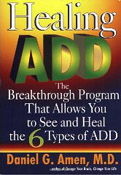 This is by far the most-quoted book among clients coming into our clinic. Dr. Amen is featured frequently on PBS. Of his many books, this is the best for helping people understand his “6 Types of ADD.” After reading this, many say it’s the first time they were clear that they (or their child, or a family member) had ADD and what type they were. It also a simple explanation – with pictures – of what the brain looks like with ADD, and why ADD has so much impact. It’s great for showing other family members. Amen includes a number of recommendations for ADD, including medications, neurofeedback, and diet, as well as family therapy and school strategies. The strength of this book is the clear ADD explanation. The section on the ADD diet is an important reminder – eat enough protein for breakfast and other meals, not just carbs for breakfast.
This is by far the most-quoted book among clients coming into our clinic. Dr. Amen is featured frequently on PBS. Of his many books, this is the best for helping people understand his “6 Types of ADD.” After reading this, many say it’s the first time they were clear that they (or their child, or a family member) had ADD and what type they were. It also a simple explanation – with pictures – of what the brain looks like with ADD, and why ADD has so much impact. It’s great for showing other family members. Amen includes a number of recommendations for ADD, including medications, neurofeedback, and diet, as well as family therapy and school strategies. The strength of this book is the clear ADD explanation. The section on the ADD diet is an important reminder – eat enough protein for breakfast and other meals, not just carbs for breakfast.
Reviewed by Michael Cohen, Director, Center for Brain Training
Parenting Children with ADHD
by Dr. Vince Monastra
Published by the American Psychological Association
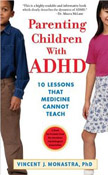 There are a ton of books for parents on ADHD – because almost every parent needs help to cope with challenging kids. One of our clients, a very well-read mom who’s really done her homework, said the Monastra book was the best one she’s read. I agree. Why? For one, if you are concerned about meds but may need to consider them, he gives the best practical, detailed explanation about ADD meds we’ve seen. It arms the parents with real information to talk to doctors, so you know what to ask, with what to be concerned, and hints on how to identify if changes need to be made. He recommends neurofeedback as an important option – he uses both approaches in his center in New York. The gold is his discussions about how to manage your child. He’s worked with thousands of kids and parents. He tells you clearly what won’t work. That’s really important. Then he gives you practical real examples of things that work when your kid won’t do what you ask. They are practical gems that parents can quickly apply to work with their child. This is a book that lives up to its title.
There are a ton of books for parents on ADHD – because almost every parent needs help to cope with challenging kids. One of our clients, a very well-read mom who’s really done her homework, said the Monastra book was the best one she’s read. I agree. Why? For one, if you are concerned about meds but may need to consider them, he gives the best practical, detailed explanation about ADD meds we’ve seen. It arms the parents with real information to talk to doctors, so you know what to ask, with what to be concerned, and hints on how to identify if changes need to be made. He recommends neurofeedback as an important option – he uses both approaches in his center in New York. The gold is his discussions about how to manage your child. He’s worked with thousands of kids and parents. He tells you clearly what won’t work. That’s really important. Then he gives you practical real examples of things that work when your kid won’t do what you ask. They are practical gems that parents can quickly apply to work with their child. This is a book that lives up to its title.
Reviewed by Michael Cohen, Director, Center for Brain Training

